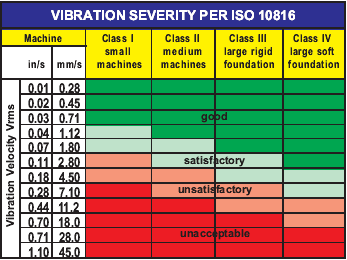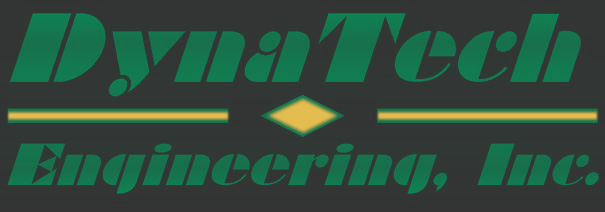We have assisted many clients with
the development of vibration specifications
and limits, creation of test plans, and providing expertise to define
and implement predictive maintenance or monitoring programs. Some
examples of our work in this area include:
 Designing procedures, specifying sensors, and setting vibration limits
for new or existing equipment. Depending on the machine, the
following standards may be used in this process:
Designing procedures, specifying sensors, and setting vibration limits
for new or existing equipment. Depending on the machine, the
following standards may be used in this process:

 ISO 10816 - A multi-volume set of standards for defining
vibration severity in terms of externally measured overall amplitude
considering size and power of the machine. Generally used in
absence of more specific acceptance criteria such as Hydraulic Institute
(HI) or American Petroleum Institute (API).
ISO 10816 - A multi-volume set of standards for defining
vibration severity in terms of externally measured overall amplitude
considering size and power of the machine. Generally used in
absence of more specific acceptance criteria such as Hydraulic Institute
(HI) or American Petroleum Institute (API).
 ANSI/HI 9.6.4 - Specifies measurement methods and acceptance
limits for vibration on various types and configurations of centrifugal
and vertical turbine pumps
ANSI/HI 9.6.4 - Specifies measurement methods and acceptance
limits for vibration on various types and configurations of centrifugal
and vertical turbine pumps
 API 610 - Defines minimum analysis and vibration test
requirements for centrifugal pumps operating in the petro-chemical
industries
API 610 - Defines minimum analysis and vibration test
requirements for centrifugal pumps operating in the petro-chemical
industries
 API 617 - Defines minimum analysis and vibration test
requirements for axial compressors, integrally geared process
centrifugal compressors and expander-compressors, as well as single
shaft centrifugal compressors for use in the petro-chemical industries
API 617 - Defines minimum analysis and vibration test
requirements for axial compressors, integrally geared process
centrifugal compressors and expander-compressors, as well as single
shaft centrifugal compressors for use in the petro-chemical industries
 Interpreting the requirements, designing any fixtures, and defining
specific tests for military standard compliance:
Interpreting the requirements, designing any fixtures, and defining
specific tests for military standard compliance:
 MIL-STD-167 - Procedures and requirements for environmental and
internally excited (primarily unbalance) vibration testing of shipboard
equipment
MIL-STD-167 - Procedures and requirements for environmental and
internally excited (primarily unbalance) vibration testing of shipboard
equipment
 MIL-STD-810G - Environmental test requirements for military
equipment, with specific emphasis on Method 513.6 (Acceleration), Method
514.6 (Vibration), Method 515.6 (Acoustic Noise), and Method 516.6
(Shock)
MIL-STD-810G - Environmental test requirements for military
equipment, with specific emphasis on Method 513.6 (Acceleration), Method
514.6 (Vibration), Method 515.6 (Acoustic Noise), and Method 516.6
(Shock)
 Recommendations for the purchase of monitoring or predictive maintenance
systems. Note that while we are very familiar with this
cost-effective way of maintaining critical equipment, we do not
represent any specific vendor of these systems so that we can select the
best hardware and software for a particular application. These
systems can involve one or more of the following technologies:
Recommendations for the purchase of monitoring or predictive maintenance
systems. Note that while we are very familiar with this
cost-effective way of maintaining critical equipment, we do not
represent any specific vendor of these systems so that we can select the
best hardware and software for a particular application. These
systems can involve one or more of the following technologies:
 Route-based periodic data collection
Route-based periodic data collection
 Real-time permanently mounted sensors
Real-time permanently mounted sensors
 Expert-system analysis of vibration and other types of data (oil,
ultrasound, motor current)
Expert-system analysis of vibration and other types of data (oil,
ultrasound, motor current)


